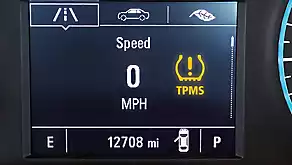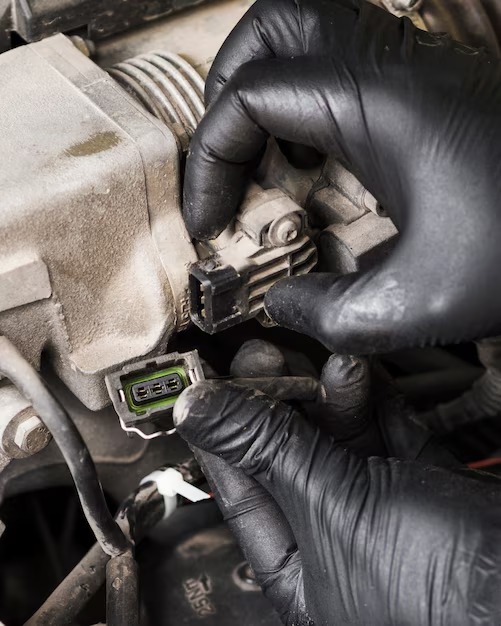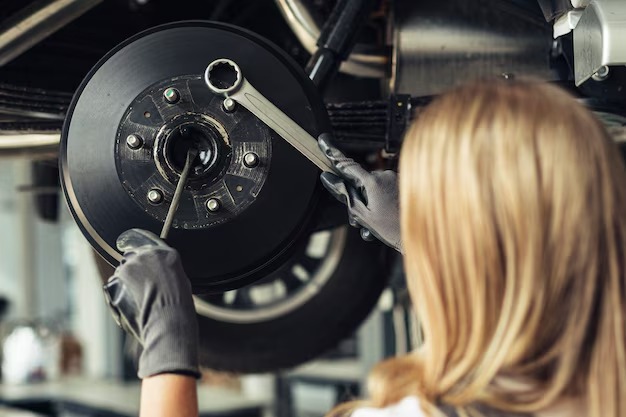What does tpms mean in a car

When you see the acronym “TPMS” in relation to your car, it may leave you wondering what it actually means. TPMS stands for Tire Pressure Monitoring System, and it is a crucial component of modern vehicles that helps to ensure your safety on the road.
The tire pressure of your vehicle is essential for optimal performance and safety. Low tire pressure can result in reduced fuel efficiency, decreased handling capabilities, and even tire failure. On the other hand, overinflated tires can lead to uneven tire wear, reduced traction, and a harsher ride.
This is where TPMS comes into play. The purpose of TPMS is to monitor the air pressure of your vehicle’s tires in real-time and alert you to any significant deviations from the recommended pressure. This can play a vital role in preventing accidents caused by tire-related issues and optimizing your driving experience.
Modern TPMS systems typically consist of sensors installed in each tire, a receiver that collects data from these sensors, and an alert system that informs the driver if any tire pressures are outside the recommended range. These sensors can measure the pressure inside the tire, as well as the tire’s temperature, allowing for accurate monitoring and early detection of potential problems.
Overall, understanding TPMS and its role in your vehicle can help you maintain proper tire pressure, improve fuel efficiency, extend tire life, and most importantly, keep you safe on the road. So, the next time you see the TPMS light illuminate on your dashboard, you’ll know that it’s alerting you to check your tire pressure and take the necessary actions to keep your car running smoothly.
Welcome to TPMS
TPMS, which stands for Tire Pressure Monitoring System, is an essential feature in modern cars that helps ensure optimal tire performance and road safety. With TPMS, drivers are notified if the air pressure in their tires drops below the recommended level, preventing potential hazards and improving fuel efficiency.
How does TPMS work?
TPMS uses sensor technology to monitor the air pressure in each tire of a vehicle. These sensors, located either in the tire valve or inside the tire itself, continuously measure the pressure and transmit the information to the TPMS control unit. The control unit then alerts the driver through a dashboard indicator if any tire pressure drops below the threshold set by the manufacturer.
Benefits of TPMS
Having a TPMS installed in your car offers several advantages. First and foremost, it enhances road safety by alerting you to any significant difference in tire pressure, which could lead to a blowout or loss of control. Additionally, TPMS helps increase fuel efficiency by ensuring that your tires are properly inflated, reducing rolling resistance. This, in turn, extends tire life and saves you money in the long run.
| Key Features of TPMS | |
|---|---|
| Real-time monitoring | Receive instant notifications about tire pressure changes |
| User-friendly interface | Easy-to-understand dashboard indicator or display |
| Customizable thresholds | Set your preferred pressure threshold according to vehicle specifications |
| Compatibility | Fits most vehicles, including cars, trucks, and SUVs |
With TPMS, you can drive with peace of mind knowing that your tire pressure is properly monitored, helping you maintain optimal tire performance and ensuring a smoother and safer journey.
The Importance of TPMS in Modern Vehicles
TPMS, which stands for Tire Pressure Monitoring System, is a critical feature in modern vehicles that helps ensure the safety and efficiency of the vehicle’s tires. This system constantly monitors the air pressure in the tires and alerts the driver if the pressure is too high or too low.
One of the key reasons why TPMS is important is because it helps prevent tire blowouts. When the tire pressure is too low, the tire becomes underinflated, which can lead to overheating and increased wear on the tire. This increases the risk of a tire blowout, which can be extremely dangerous, especially at high speeds.
In addition to preventing blowouts, TPMS also helps improve fuel efficiency. When the tire pressure is too low, the vehicle has to work harder to move, which leads to increased fuel consumption. By ensuring that the tires are properly inflated, TPMS helps optimize fuel efficiency, saving the driver money on fuel costs.
Another important benefit of TPMS is that it helps extend the lifespan of the tires. When the tire pressure is too high or too low, it can cause uneven tire wear, reducing the lifespan of the tires. By constantly monitoring the tire pressure, TPMS helps ensure that the tires wear evenly, allowing them to last longer.
Furthermore, TPMS also contributes to a smoother and more comfortable ride. When the tire pressure is too low, the tires become softer, which can result in a bumpy and uncomfortable ride. By maintaining the correct tire pressure, TPMS helps ensure a smoother and more enjoyable driving experience.
In conclusion, TPMS plays a crucial role in modern vehicles by ensuring the safety, efficiency, and longevity of the tires. By constantly monitoring the tire pressure and alerting the driver of any deviations, TPMS helps prevent tire blowouts, improve fuel efficiency, extend tire lifespan, and provide a smoother ride. It is important for drivers to understand the significance of TPMS and to regularly check and maintain their tire pressure for optimal performance.
How Does TPMS Work?
TPMS, or Tire Pressure Monitoring System, is a built-in device in a car that is designed to monitor the pressure of the tires. It works by using sensors that are installed in each tire to measure the air pressure. The sensors transmit the data wirelessly to a central control unit in the car, which then displays the tire pressure information on the dashboard.
There are two types of TPMS: direct and indirect. Direct TPMS uses sensors to directly measure the tire pressure, while indirect TPMS uses the wheel speed sensors to indirectly monitor the tire pressure. Both types have their advantages and disadvantages, but they both serve the same purpose of alerting the driver if the tire pressure is too low or too high.
When the tire pressure is below the recommended level, the TPMS will activate a warning light on the dashboard to alert the driver. This is important because driving with underinflated tires can affect the handling and performance of the car, as well as increase the risk of a tire blowout or a flat tire. On the other hand, if the tire pressure is too high, it can cause uneven tire wear and reduce traction.
In addition to monitoring the tire pressure, some TPMS systems can also provide other information, such as the temperature of the tires. This can be useful in identifying potential tire issues, such as overheating or a malfunctioning sensor.
Overall, TPMS is an important safety feature in modern cars as it helps to ensure that the tires are properly inflated, which can improve fuel efficiency, tire life, and overall driving safety.
The Benefits of TPMS for Car Owners
TPMS, or Tire Pressure Monitoring System, is a technology that has become increasingly common in modern cars. This system provides many benefits for car owners, improving both safety and convenience.
One of the main benefits of TPMS is enhanced safety. Proper tire pressure is crucial for optimal performance and safety on the road. With TPMS, car owners can easily monitor the tire pressure in real-time, ensuring that it is within the recommended range. This helps prevent accidents caused by underinflated or overinflated tires, such as blowouts or loss of control. The system alerts the driver if the tire pressure deviates from the normal range, allowing for prompt action to be taken.
Another benefit of TPMS is improved fuel efficiency. Underinflated tires can increase fuel consumption by causing the vehicle to work harder and use more energy. With the tire pressure monitoring system, car owners can quickly detect any tire pressure abnormalities and address them promptly, resulting in better fuel efficiency and cost savings in the long run.
Furthermore, TPMS helps increase the lifespan of tires. Properly inflated tires wear more evenly and last longer, reducing the frequency of tire replacements. This saves car owners money in the long term by extending the life of their tires and reducing maintenance costs.
In addition to safety, fuel efficiency, and tire longevity, TPMS also offers convenience. Having this system installed in a car eliminates the need for manual tire pressure checks, which can be time-consuming and inconvenient. With TPMS, car owners can easily keep track of the tire pressure without needing to use a tire pressure gauge. This makes it easier to maintain proper tire pressure and ensures that the car is always ready for a smooth and safe ride.
In conclusion, TPMS provides numerous benefits for car owners. It enhances safety by alerting drivers to tire pressure issues, improves fuel efficiency, prolongs tire life, and offers the convenience of real-time monitoring. Car owners who invest in TPMS can enjoy a safer, more efficient, and cost-effective driving experience.
Common Issues and Troubleshooting Tips for TPMS
The Tire Pressure Monitoring System (TPMS) is a vital component of modern cars that helps ensure optimal tire pressure for safety and performance. However, like any electronic system, TPMS can experience issues that require troubleshooting. Here are some common issues and tips to resolve them:
1. TPMS Warning Light Illuminated
If you see the TPMS warning light on your dashboard, it indicates a problem with the system. First, check all tire pressures with a gauge and adjust them if necessary. If the pressures are correct, there might be an issue with one or more TPMS sensors. Have them diagnosed and replaced if needed.
2. TPMS Sensor Battery Failure
TPMS sensors have an internal battery that can eventually fail over time. If a sensor’s battery dies, it will need to be replaced. Typically, the entire sensor unit needs to be replaced, as the battery is not replaceable separately. Consult your vehicle’s manual or a professional mechanic for assistance.
3. TPMS Sensor Programming Issue
Sometimes, when replacing TPMS sensors or changing tires, the new sensors need to be programmed to communicate with the car’s system. This requires a special TPMS tool or programming device. If you don’t have the necessary equipment, visit a tire shop or auto service center to have the sensors programmed correctly.
4. TPMS Sensor Interference
Some aftermarket modifications, such as metal valve stems, can interfere with TPMS sensor signals. If you recently made any modifications to your wheels or valve stems, they could be causing the TPMS system to malfunction. Consult a professional to determine if the modifications need to be adjusted or removed.
5. TPMS System Malfunction
If the TPMS warning light remains illuminated despite addressing tire pressures and replacing faulty sensors, there might be a malfunction in the TPMS system itself. In this case, professional diagnostic equipment will be needed to pinpoint the issue. Visit a qualified mechanic or dealership for further assistance.
Note: Proper tire maintenance is crucial to the longevity and performance of your TPMS. Regularly check tire pressures, rotate tires, and ensure they are properly inflated to prevent unnecessary TPMS issues.
In conclusion, TPMS is a valuable system that ensures tire safety, but it can encounter various issues. By following these troubleshooting tips and seeking professional help if needed, you can maintain a reliable TPMS and enjoy a safer driving experience.
TPMS Maintenance and Best Practices
Maintaining your TPMS (Tire Pressure Monitoring System) is crucial to ensure optimal performance and safety on the road. Here are some best practices to follow:
Regularly Check Tire Pressure
It is important to regularly check your tire pressure using a reliable tire pressure gauge. Underinflated or overinflated tires can affect your vehicle’s handling and fuel efficiency. Refer to your vehicle’s manual or the sticker on the driver’s side door jamb for the recommended tire pressure.
Inspect TPMS Sensors
Inspect the TPMS sensors for any signs of damage or corrosion. These sensors are usually located inside the tire, attached to the valve stem. If you notice any issues, such as a damaged sensor or missing valve cap, it is recommended to have it inspected and replaced by a qualified technician.
Replace TPMS Sensor Batteries
The TPMS sensor batteries have a limited lifespan, typically lasting around 5 to 7 years. If you notice that one or more sensors are not transmitting a signal or are displaying incorrect readings, it may be time to replace the batteries.
It is advisable to replace all the TPMS sensor batteries at the same time to ensure consistent performance. Consult your vehicle’s manual or contact a trusted automotive professional for guidance on the compatible batteries.
Reset TPMS System After Tire Service
If you have recently had a tire rotation, replacement, or any other tire service, it is essential to reset the TPMS system. Failure to reset the system may result in inaccurate readings or false warning alerts. Refer to your vehicle’s manual for instructions on how to reset the TPMS system, or seek assistance from a qualified technician.
Note: Failure to properly maintain and service your TPMS can lead to inaccurate readings, compromised safety, and increased risk of tire failure. It is always recommended to consult a qualified technician or refer to your vehicle’s manual for specific maintenance guidelines.
By following these TPMS maintenance best practices, you can ensure accurate tire pressure monitoring and enhance your overall driving experience.
TPMS Regulations and Standards
TPMS regulations and standards vary by country and region, with different requirements and guidelines put in place to ensure the safety and functionality of TPMS systems.
In the United States, the National Highway Traffic Safety Administration (NHTSA) has set specific regulations for TPMS. According to these regulations, all light vehicles (passenger cars, trucks, and SUVs) manufactured after September 1, 2007, must be equipped with a TPMS system that meets certain performance standards.
The NHTSA regulations require TPMS systems to monitor the inflation pressure of all four tires and provide an alert to the driver when the pressure in any tire drops below a certain threshold. The alert can be in the form of a warning light on the dashboard or an audible warning.
Europe has its own set of regulations for TPMS systems. The European Union (EU) implemented regulations requiring all new passenger vehicles to be equipped with a TPMS system starting from November 1, 2014. The EU regulations specify that TPMS systems must monitor the inflation pressure of all four tires and provide a warning to the driver when the pressure drops below a certain level.
In addition to government regulations, there are also industry standards that manufacturers follow when developing TPMS systems. The Society of Automotive Engineers (SAE) has published standards for TPMS technology, including performance requirements and testing procedures.
These standards help ensure that TPMS systems are accurate, reliable, and standardized across different vehicle makes and models. They cover aspects such as sensor functionality, communication protocols, and system performance.
Compliance with regulations and adherence to industry standards are essential for manufacturers to ensure the safety and effectiveness of TPMS systems. By following these regulations and standards, TPMS systems can help drivers maintain proper tire inflation and reduce the risk of tire-related accidents.
Choosing the Right TPMS for Your Vehicle
When it comes to choosing the right TPMS (Tire Pressure Monitoring System) for your vehicle, there are a few factors to consider. A TPMS is an essential safety feature that monitors the air pressure in your car’s tires and alerts you if the pressure is too low or too high. Here are some key points to keep in mind when selecting a TPMS:
Compatibility: Make sure that the TPMS you choose is compatible with your vehicle’s make and model. Different cars may require different types of TPMS, so it’s important to check the specifications before making a purchase.
Type: There are two main types of TPMS: direct and indirect. Direct TPMS uses pressure sensors inside each tire to measure the air pressure, while indirect TPMS uses the vehicle’s anti-lock braking system (ABS) to monitor tire pressure. Direct TPMS provides more accurate readings, but indirect TPMS can be more cost-effective for older vehicles.
Display: Consider what type of display you want for your TPMS. Some models have a standalone display that can be mounted on your dashboard, while others integrate with your vehicle’s existing display. Choose a display that is easy to read and understand while driving.
Alerts: Check if the TPMS has audible and visual alerts for low and high tire pressure. These alerts can help you take immediate action and prevent any potential tire-related issues on the road.
Installation: Look for a TPMS that is easy to install or can be installed by a professional. Some TPMS models require special tools or programming, while others are more user-friendly and can be installed with basic tools.
Reliability: It is crucial to choose a TPMS from a reputable brand that is known for its reliability and accuracy. Read customer reviews and consider the warranty provided by the manufacturer before making your decision.
Price: Set a budget for your TPMS purchase, but keep in mind that prioritizing quality and functionality over price is essential for safety. Remember that a good quality TPMS can save you money in the long run by preventing tire damage and improving fuel efficiency.
By considering these factors, you can choose the right TPMS for your vehicle, ensuring optimal safety and tire performance on the road.
Q&A: What does tpms mean in a car
What does TPMS stand for?
TPMS stands for Tire Pressure Monitoring System.
Why is TPMS important in a car?
TPMS is important in a car because it helps ensure proper tire inflation and improves safety. It alerts the driver when the tire pressure is low, preventing potential accidents caused by underinflated tires.
How does TPMS work?
TPMS works by using sensors mounted on each tire to monitor the air pressure. These sensors send data to a central control unit in the car, which then displays the tire pressure information on the dashboard or alerts the driver if the pressure is too low.
What are the benefits of TPMS?
Some benefits of TPMS include improved safety, better fuel efficiency, longer tire life, and reduced risk of tire blowouts. It helps drivers maintain proper tire pressure, which can enhance vehicle handling and reduce the chance of accidents.






